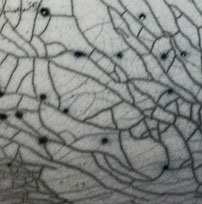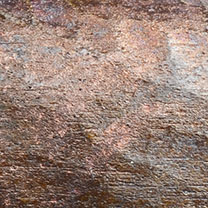The raku firing process, introduced in Japan in the 16th century and prized for its dynamic and unpredictable surfaces, differentiates itself from other firing process by the fact the pot is removed from the kiln while red-hot and not allowed to cool. While the “recipe” for raku differs from artist to artist, at Valentine Studios, our raku artworks are fired in a propane kiln to roughly 1900 degrees, or whenever the glaze takes on a molten, glassy appearance. Once the pots reach temperature, they are removed from the kiln while red-hot with raku tongs (similar to blacksmith tongs) and immediately put in a barrel and covered with sawdust. The sawdust reduces the oxygen in the barrel, and around the artwork, resulting in metallic glazes and a black clay-body. The crackle effect is caused by thermal shock; the glaze cools at a faster rate then the clay, essentially shattering the glaze on the surface. Once the pots have cooled, they are removed from the sawdust, washed, and scrubbed with steel wool and pumice soap. This cleaning removes the smoke and ash the pot acquired from the smoldering sawdust and reveals the surface effects of the glazes.







